Waugh Thistleton has submitted an entirely timber tower for planning in Hackney, London. To be constructed entirely in timber, the nine-storey high-rise is set to be the tallest timber residential building in the world. Comprising both private and affordable housing, the scheme will comprise of twenty-nine apartments each with their own balcony. The tower has been commissioned by house builder Telford Homes and is scheduled to start on site in the autumn.
The building has been designed using a cross-laminated timber panel system. The system has been pioneered by manufacturers KLH of Austria and is akin to jumbo plywood, arriving on site in panels up to 9m in length. This will be the first building in the world of this height to construct not only load-bearing walls and floor slabs but also stair and lift cores entirely from timber.
Each of the panels is prefabricated including cutouts for windows and doors. As the panels arrive on site they are immediately craned into position, dramatically reducing the time on site. The entire nine-story structure will be up and built within nine weeks.
Timber absorbs carbon throughout its natural life and continues to store that carbon when cut. The fabric of the Murray Grove tower will store over 181 tonnes of carbon. Additionally, by not using a reinforced concrete frame, a further 125 tonnes of carbon are saved from entering the atmosphere. This is equivalent to 21 years of carbon emissions from a building of this size.
The concept for the façade is inspired by the work of artist Gerhard Richter. Recording the changing light and shadows formed on the vacant site by surrounding buildings and trees, the pattern was captured through a sun-path animation. The resulting image was pixellated and blurred, then picked up and wrapped around the building.
The exterior cladding forming this pixilated image is made up of over 5,000 individual panels across the building in three shades: white, grey and black. The 1200×150mm panels are manufactured by Eternit and made up of 70% waste timber.
Each of the twenty-nine apartments will have their own internal balcony and with the deep-set windows these will appear as the ‘missing pieces’ on the façade; an additional punctuated rhythm over the abstract image of the façade.
Architect: Waugh Thistleton [ Via: Dezeen ]
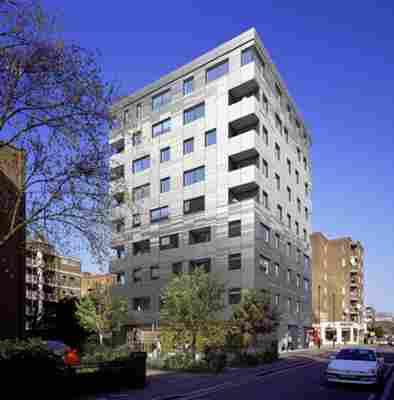
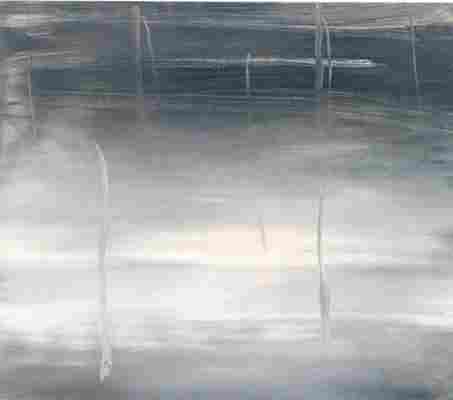
Tiny home setups that prove why micro-living will be the next big trend: Part 5
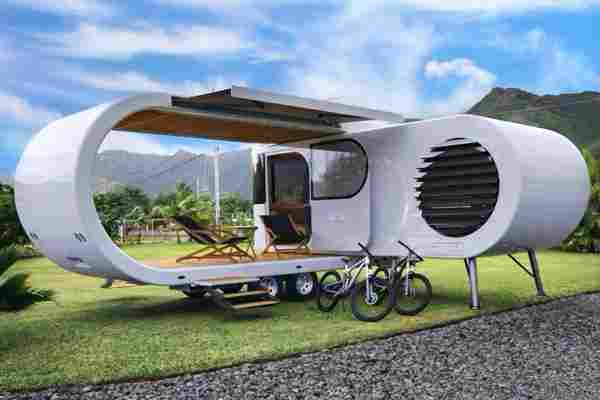
Tiny homes are all the craze now, but they’re not simply a trend, it seems like they are here to stay. Sustainability and minimal and cleaner ways of living have never been more imperative. With the COVID-19 pandemic shaking the world up, everyone is now focused on making more conscious and smarter decisions. Could tiny homes be the space-saving and sustainable living solution that we all need? I do think so!
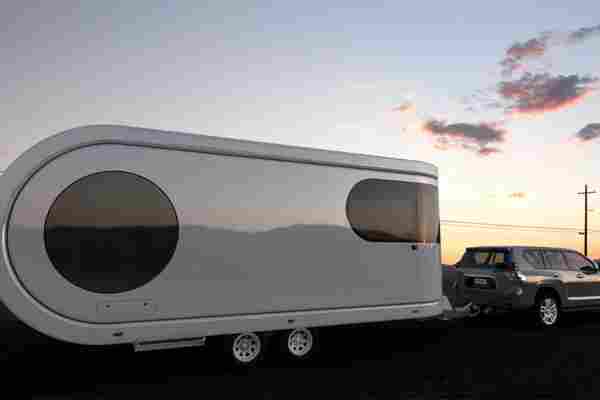
W2 Architecture’s revolutionary trailer design, Romotow , the name an amalgamation of ‘room to move’ contains all the usual RV features but with an innovative 90-degree twist. With the press of a simple electric button, it swivels open, rotating at 90 degrees, to reveal an open synthetic teak deck, and 70% more living space.
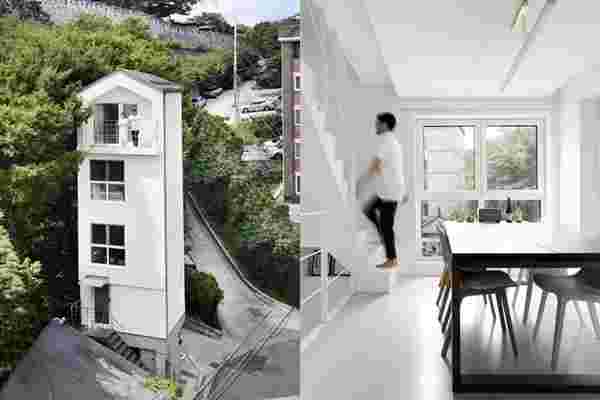
Smaller Architects built this tiny home in Seoul, Korea. This four-story tall vertical tiny home is called ‘Seroro’ which literally means ‘vertically’. The rooms have been stacked one on top of the other, with the first floor comprising of the living room and the common washroom. The ground floor functions as a parking lot, whereas the second floor houses the kitchen and the dining area, and the third floor includes the bedroom and a private washroom. Lastly, a dressing room with a bathtub is situated on the fourth floor. Quaint, compact, and spacious at the same time, don’t you think?
Design Studio Andrés and José designed a mobile tiny house that aims to provide shelter to homeless people. Deemed as ‘an urban domestic object’ by the designers themselves, ‘Rodar’ could be a major source of relief to homeless people, providing them with a simple, minimal yet comfortable living space. Its structure and build are very similar to the ambulances found in many Latin American countries. The geometric, box-like compact home does look quite intriguing to me!
Room+ Design & Build renovated an old tiny house in Ho Chi Minh City, Vietnam. Featuring translucent glass blocks, the two-story home consists of a shop on the ground floor, and a minimal living space with two bedrooms on the upper floors. The glass facade allows natural light to continuously stream into the home, creating an open and relaxed space.
Fernando Mastrangelo designed a tiny house from salt, sand, and powdered glass in Times Square. Quite literally named ‘Tiny House’, the home is built from discarded and then recycled materials such as plastic and glass. The cave-like structure showcases an ombre effect on its outer facade, owing to the use of recycled plastic. Whereas glass was used to build the walls.
Dunkin’ Donuts and New Frontier Tiny Homes build a mobile tiny home that literally runs on discarded Dunkin’ Donuts coffee grounds! The transportable home is powered by a biofuel made up of 80 percent coffee oil extracted from 65,000 pounds of discarded coffee grounds. The home includes a cedar porch, a living room, multifunctional furniture, a fully functional kitchen, a comfy bunk bed, and beautiful wooden floors.
While Vancouver has quickly become one of the most expensive cities to live in, it is not densely populated and there are a lot of vacant spaces that can be put to better use – Shifting Nests sustainable tiny homes is that use! This project wants to transform empty parking lots into a community with gardens and low-cost homes. “The ‘nests’ are a prefabricated housing solution consisting of plywood, metal cladding, and corrugated polycarbonate on a series of simple frames.
Cube Two is a 263-square-foot home that is designed for the future and smart living. This modern compact home is a prefabricated structure that already comes fitted with the latest home appliances that can all be controlled by an AI assistant named Canny. The exterior has smooth curved corners that give it a friendly vibe and the interior offers enough space for a family of four to live comfortably with two bedrooms and an open living area. To make it feel roomier, there is a skylight that runs across the ceiling and floods the space with natural light, and also provides a wonderful frame of the night sky.
One of my favorite things about tiny homes is the loft-style beds because they give you a little private cozy corner and that is exactly how the bedroom in Natura is set up. It has a multifunctional king-sized bed with plenty of storage under the frame. The bedroom also has a single large window that makes it more spacious and allows for a lot of natural light to flood your top floor. The space optimization goes beyond the bedroom, there are many built-in spaces for you to put the things you own like under the stairs as well as in the walls!
The Pacific Harbor is a tiny house built on a 30’x8.5’ triple axel Iron Eagle trailer – compact, convenient, and classy. The interiors are kept light and breezy to manifest the feeling of spaciousness. The tiny home includes a downstairs flex area that can be turned into a bedroom or home office, a sleeping loft in the back, and stainless steel appliances in the kitchen.
Sustainable Cabin Designs that provide the perfect architectural escapism in eco-friendly style!
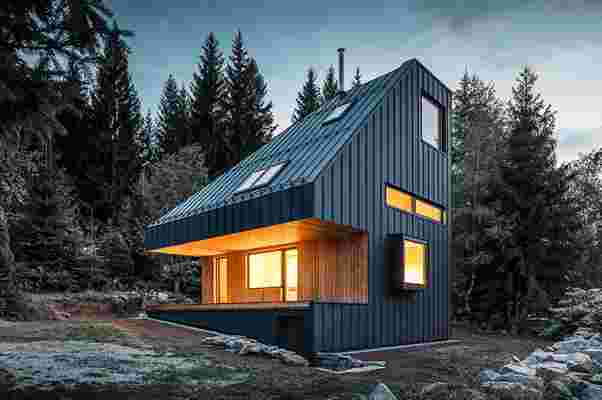
Living a sustainable and eco-conscious life in today’s crumbling world has become imperative! And, architects are trying their level best to create structures that reduce their carbon footprint and encourage a sustainable and clean lifestyle. Homes, offices, hotels – almost every type of structure is being pushed down the sustainable route. And, why shouldn’t cabins be included in this mix? We all enjoy a peaceful cabin retreat every now and then, and if we can do it in a sustainable style, then why not?! We’ve curated some of our favorite sustainable cabin designs that not only take care of Mother Earth but also take our breath away! These sustainable cabins will have you vacationing in the most eco-friendly manner possible!
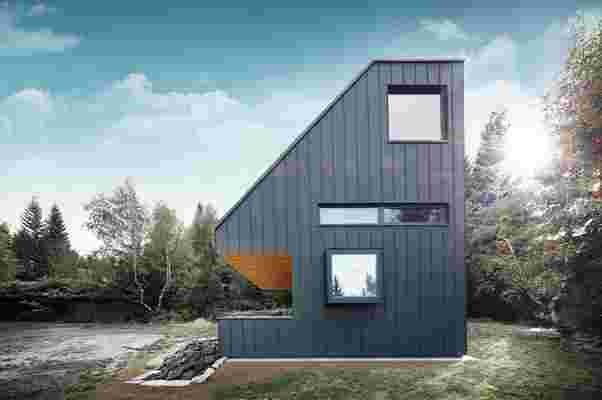
The architectural CMF for the cabin has been inspired by the spruce trees that surround it, so there are a lot of shades of gray and dark green. Weekend House Nové Hamry features connection points for solar panels and vertical wind turbines to make it energy self-sufficient. The roof and most of the exterior are covered in the durable, anthracite-colored aluminum cladding. This resembles oiled black wood and adds to the minimal, modern, elegant aesthetic of the cabin. The area gets a lot of heavy snow so to manage the load, the angular design also features a steeply sloped roof. The structure is constructed from cross-laminated timber panels.
Careful not to disrupt the area’s wooded landscape and to maintain the cabin’s initial off-grid aspirations, Marc Thorpe equipped each cabin hotel with a solar kit and roof to ensure the cabin has plenty of renewable energy available for power. Each solar kit comes with a 1800W solar generator to provide backup power for the four 100W 12V mono solar panels that line the cabins’ roofs. Inside, guests enjoy a minimal interior that’s lined and finished in plywood. Built as supplementary retreats for guests of the area’s main hotel, Tara Luanei, Canton House offers a respite in nature that’s unique to the Carpathian Mountains.
This cabin is built on Lake Saimaa and is right on the border of lush woods and endless serene water. The prefabricated cabin only takes one day to be assembled. Helsinki-based architecture firm constructed Kynttilä from cross-laminated timber (CLT) with the exteriors featuring larch board cladding. CLT is a wonderfully eco-friendly construction material that offers high strength and structural simplicity for cost-effective buildings. It has a much lighter environmental footprint than concrete or steel. CLT is also quicker to install, reduces construction waste on-site, improves thermal performance, with light handling duties making it better for health and safety, and is versatile enough to be molded according to different designs.
Cabin One is described as a passionately designed home for the future and its minimalist look certainly appeals to millennials who will now be able to buy homes given that the lockdown is making them spend less on avocados ( you know what I am talking about ). What I love about Cabin One is that it promotes flexible micro-living through its modular build. You can customize the 25 square meters of space as per your needs – it could be a beautiful cabin for one, a holiday home for two, or a quirky office space that stands in between an Airbnb and WeWork (given that the future is all about working remotely, did I just come up with the next million-dollar startup?). “We have reduced the complexity of the construction industry to three important elements: comfort, quality, and user experience. We do not think in square meters, we think in features,” says Simon, Cabin One’s designer.
Casa Ojalá has been constructed with carefully selected timbers, fabrics made from recycled plastic, and handmade ceramics. It also has integrated photovoltaic panels, a rainwater recovery system, and a black water depuration advanced biological plant – all of which allow it to be set up even in the most remote locations. Each cabin will source local materials and therefore no destination will have the same casa but each will be woven with the roots of the land creating infinite possibilities within the same floor area anywhere in the world.
ZeroCabin wants to change the habits of its occupants by providing the tools to live sustainably. “It is not about ‘what happens if the water-scarce,’ the questions these days should be ‘if the waters scarce, are my habits according to the water available in the place where I live? If the solar energy is not enough, are my consumption habits according to the energy available?” adds the team when talking about the thought process behind the design. All ZeroCabins regardless of the modality you buy (turnkey or DIY) have a structural base that allows optimal capture of their only two inputs, just like trees: sun and rainwater. The cabin maximizes functionality oversize but includes a wide range of modifications you can do based on the land you want to put it on and as long as it is aligned with their environmental guidelines.
Named the Kvivik Igloo , the tiny, prefabricated houses perch the hilltops of Kvivik, overlooking the bay and surrounding mountains. Designed to look like tiny hobbit cottages, each Kvivik Igloo is built with a hexagonal frame and design elements meant to echo the past. Lined with asphalt panels, the Kvivik Igloos can sprout grass and greenery from their roofs and sides to really transport residents into their favorite hobbit fairytale. The igloo’s living roof not only adds to its charm but also to the tiny home’s sustainability factor, creating a heightened nesting place for birds and woodland creatures alike. Underlining their sustainability efforts, the builders use passive house construction practices and natural materials to build the Kvivik Igloos, including wood, glass, aluminum, and rubber.
Nestled just 20 minutes from San Miguel de Allende, Mexico (a UNESCO World Heritage Site), Casa Etérea provides breathtaking views of the volcanic and starry landscape. “The vision was to create a theatre to nature, so sustainability was crucial in achieving a truly complete integration with the environment,” explains Ashoka. Not only does the glass and mirror exterior reflect the hillsides and mesquite trees, but a special patterned, ultraviolet coating allows birds to see it as a structure that eliminates the risk of impact. The off-the-grid cabin can host two people comfortably within the 75-square-meter space. It is 100% powered by solar panels and includes all amenities for a comfortable stay like a king-sized bed, a luxurious living space, a kitchen, and laundry facilities. Casa Etérea includes a water harvesting system that collects and reuses rainwater for daily activities and is enough to fill the striking copper bathtub perched next to the bed. Ashoka chose natural materials like jute, leather, wood, and stone to align the interior aesthetic with the scenic setting of the cabin while keeping sustainability at its core.
Set on a rugged, 8-acre site on the secluded side of the island, this cabin offers magical views of the lush, lichen-covered rainforest and the serene bay water that surrounds it. The island is secluded from the dense population of Canadian cities but recent developments on and around it have left the natural sanctuary vulnerable. The Office of McFarlane Biggar Architects + Designers (OMB) has created an environmentally friendly alternative with a small environmental footprint to encourage sustainable travel and construction. “The views and access to sunshine were really the key considerations that helped us position the home,” says the architect.
The House in Chamois is made of our sustainable architecture dreams – a modern, prefabricated home by Torino-based firm Leap Factory. All projects are called ‘Leap Houses’ and each home’s entire design is constructed with a modular system built of natural, recyclable materials that allow for maximum flexibility. Every component for the House in Chamois was produced and designed in Italy to reduce environmental impact and construction site waste. The home was made for a couple who has a deep love for the outdoors so immersing them in the natural landscape was vital to the design. The two-story tiny house is used as a base for exploring the alpine landscape while blending into it with its angular, contemporary, and minimalist form.








